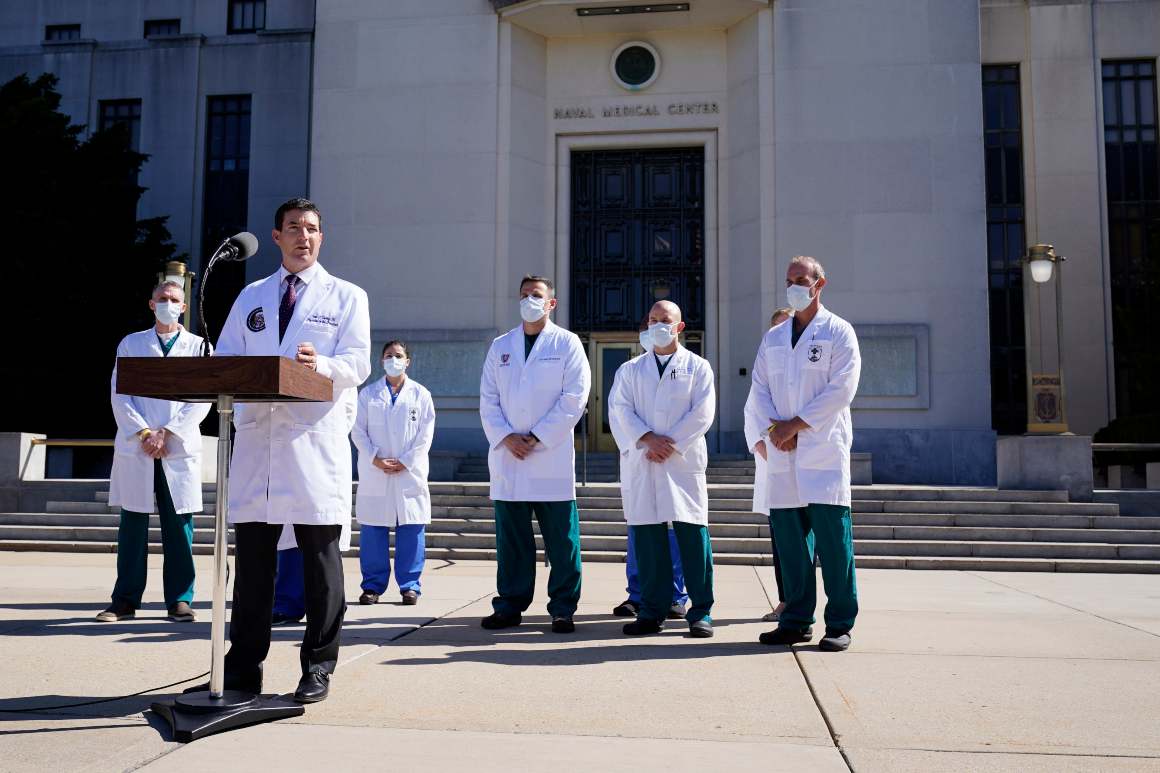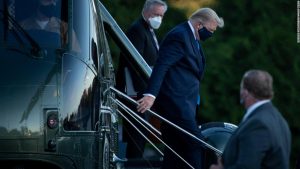President Donald Trump is “doing very well” as he battles the coronavirus, the president’s physician said Saturday, while indicating the president’s diagnosis came far earlier than the White House has said.
In a briefing to the press outside Walter Reed medical center, where the president has been since Friday night, Dr. Sean Conley said he was “extremely happy with the progress the president has made,” noting that the first several days are critical to determining how a coronavirus infection will progress. Trump’s medical team also said the president is fever-free and not currently on supplemental oxygen — a step frequently needed for patients with severe coronavirus cases.
“Yesterday and today he has not been on oxygen,” Conley said.
Saturday’s briefing was the most thorough update on Trump’s health since he revealed his positive test early Friday morning. But the comments immediately triggered a flurry of questions about whether Trump and the White House had misled the public, including his own supporters, about the circumstances of Trump’s diagnosis, as well as the severity of his symptoms.
Members of Trump’s medical team said it had been 48 hours since Trump started a key element of his treatment and 72 hours since he was diagnosed with coronavirus. But Trump only revealed his positive status early Friday morning — about 36 hours before Saturday’s briefing. If accurate, the timeline suggests Trump knew about his status on Wednesday — the day of a campaign trip where he was surrounded by a largely unmasked crowd in Minnesota — and long before he traveled to a fundraiser in New Jersey on Thursday after a senior aide had been diagnosed.
After Conley’s briefing, the White House press pool reporter conveyed a statement from “a source familiar with the president’s health” that appeared to explain why the president had been hospitalized if he had not been on supplemental oxygen.
“The president’s vitals over the last 24 hours were very concerning and the next 48 hours will be critical in terms of his care,” the statement said. “We’re still not on a clear path to a full recovery.”
At his briefing Conley revealed for the first time specifics on some of Trump’s vitals, noting that his blood pressure and heart rate were both within Trump’s normal range. Conley also said Trump’s oxygen saturation — the level of the gas in his blood — was 96 percent, squarely within the normal range.
Still, Conley was hesitant to indicate how soon the president might be discharged from the hospital.
“I don’t want to put a hard date on that,” he said.
Shortly after the president announced his infection, he went largely silent — dropping his obsessive tweeting and not making any appearances. Throughout Friday, it was left to aides and allies to provide insight into his “mild symptoms.” Then, early Friday evening, the White House said it was taking Trump to Walter Reed hospital out of an “abundance of caution” for “a few days.” In a memo before the trip, Conley described the president as “fatigued but in good spirits.”
The sudden silence from Trump started to worry aides and allies as they waited for guidance on how to message the situation.
Later that night, Conley revealed the president had started taking the antiviral drug remdesivir and was “doing very well.” Preliminary data has shown the drug can help reduce recovery time for hospitalized coronavirus patients. But research has been inconclusive on whether the drug lowers the risk of death.
Trump has also completed an infusion of an experimental antibody drug produced by Regeneron — receiving the highest dosage being tested in the ongoing clinical trial — and is taking aspirin, zinc and vitamin D.
Notably, there has been no significant information released on Trump’s vitals, such as his oxygen levels or blood pressure. Conley did say late Friday that Trump was not receiving supplemental oxygen.
To this point, Trump’s only public appearance related to his condition has been a brief, 18-second video he released before going to Walter Reed, thanking his supporters and proclaiming, “I think I’m doing very well.” He reiterated the message in a late-night tweet: “Going welI, I think! Thank you to all. LOVE!!!”
Late Friday night, House Minority Leader Kevin McCarthy tweeted that he had spoken by phone with Trump, calling the president “upbeat” and predicting: “Our president is strong and will beat the virus!”
With Trump in the hospital, Vice President Mike Pence has remained in his residence, even as the Trump campaign on Saturday announced Pence would headline a MAGA rally in Arizona on Thursday. Pence tested negative for Covid-19 on Friday and stepped in for Trump to host a scheduled conference call on the coronavirus that afternoon. Pence’s schedule for Saturday indicated he would remain at home. If Trump’s condition worsens, the 25th Amendment allows for the president to transfer his powers to the vice president.
Trump’s infection is part of an outbreak that has raced through the White House, the Trump campaign and Republican senators on Capitol Hill.
The first indication of a viral spread appeared Thursday evening when the White House confirmed that Hope Hicks, a close Trump aide who travels regularly with the president, had contracted the disease. Then a cascade of positive tests were revealed over the next 36 hours — Trump’s campaign manager, the head of the Republican National Committee and three GOP senators were just a few of people affected.
The infections are likely linked to several Republican gatherings over the last week.
Last Saturday, the White House held a Rose Garden ceremony to introduce Amy Coney Barrett, Trump’s pick to replace Ruth Bader Ginsburg on the Supreme Court. Attendees at the event were largely maskless, and there were indoor receptions before and after the outdoor ceremony.
In the days that followed, the president traveled to several rallies and the first presidential debate, repeatedly putting him and his top aides in close proximity on helicopters and planes.



















